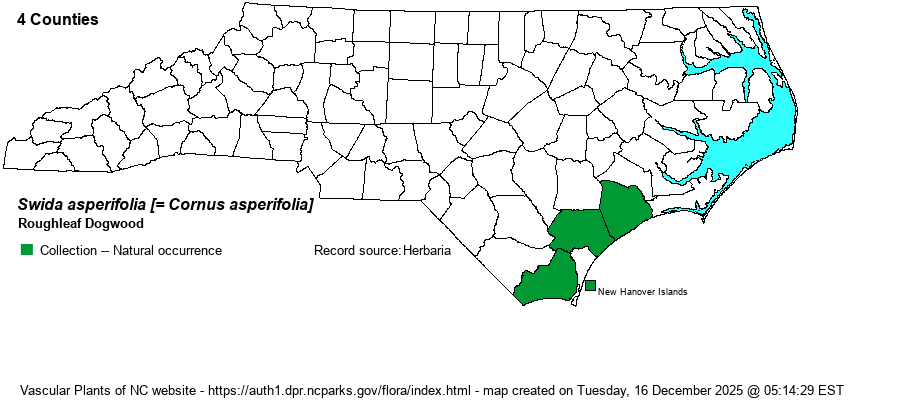| Author | (Michaux) Small | |
| Distribution | Very small range in the state, limited to a few areas near the southern coast. Known for certain only from Onslow to Brunswick counties.
This is a strictly Southern species, limited essentially to the Coastal Plain, from southeastern NC to central FL, and west to MS.
| |
| Abundance | Very rare to rare, and quite local, in Onslow and Pender counties; perhaps of historical occurrence in New Hanover and Brunswick counties. However, at least at one site in Pender County, near Rocky Point, it is common in a few forest stands. This is a State Endangered species. | |
| Habitat | In NC it is strictly found over calcareous/marl rock, and thus is a specialist of high pH soil. It occurs mostly in the very rare Wet Marl Forest natural community, which is a poorly drained, moist (but not overly wet) hardwood forest type. At Camp Lejeune, a population occurs in the very rare Calcareous Coastal Fringe Forest, a maritime hammock forest type. Both forest types have high species diversity and several other rare plants. | |
| Phenology | Blooms in May and June, and fruits in August and September. | |
| Identification | This is a medium-sized to fairly large deciduous shrub that grows to 10-15 feet tall. The opposite leaves are broadly elliptic and average somewhat smaller than other dogwoods, averaging about 2.5-3 inches long. Though typical in dogwood vein pattern, the leaves have a characteristically rough/scabrous texture above and are rather hairy below. As the species has a similar inflorescence – a broad, flat-topped white flower cluster – to most other dogwoods, you normally must get to a shrub and feel the surfaces of the leaves to confirm that you have identified this rare species from the similar but much more common Stiff Dogwood (C. foemina). When not in bloom or fruit, a sapling Flowering Dogwood (C. florida) might resemble this species, and thus you must closely examine the leaves to be sure of identification. | |
| Taxonomic Comments | Weakley (2020) names this genus as Swida, following recommendations of several recent references. Weakley (2022) indicates that the populations of this species in NC and SC have morphology in between that of S. foemina and S. asperifolia farther to the south, and that our plants might be hybrids of these two.
| |
| Other Common Name(s) | Eastern Roughleaf Dogwood, Southern Roughleaf Dogwood (these names used if C. drummondii is named as Midwestern Roughleaf Dogwood), Toughleaf Dogwood | |
| State Rank | S1 | |
| Global Rank | G4 | |
| State Status | E | |
| US Status | | |
| USACE-agcp | | |
| USACE-emp | | |

